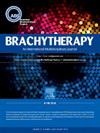Long-term rectal patient-reported quality of life outcomes among patients treated with Pd-103 LDR prostate brachytherapy
IF 1.7
4区 医学
Q4 ONCOLOGY
引用次数: 0
Abstract
PURPOSE
Rectal toxicity is a dose-limiting side effect of definitive prostate radiation. There are limited long-term data on patient-reported rectal toxicity outcomes following Pd-103 LDR prostate brachytherapy, as well as some recent data suggesting high rates of long-term toxicity from LDR brachytherapy overall. This study reports incidence and predictors of late patient-reported rectal quality of life outcomes after Pd-103 prostate brachytherapy.
MATERIALS AND METHODS
This study analyzed a prospectively collected IRB-approved database of men receiving LDR prostate brachytherapy between 12/2004 and 12/2018 at our institution. Patients received either LDR monotherapy or combined with IMRT to prostate and/or pelvic lymph nodes. Outcomes data related to rectal toxicity were evaluated based on Bowel subdomain of the Epic-26 questionnaire, which was routinely given to patients at initial consult and follow up visits. Bowel “Bother” score (“How big a problem have your bowel habits been during the last 4 weeks”) was analyzed for overall bowel function assessment. Patients were grouped into those reporting ‘Moderate Problem’ or worse and those reporting ‘No, Very Small, or Small’ problem. In addition, composite Function and Bother scores were analyzed. Statistical analyses assessed the correlation between the V100% (volume of rectum receiving 100% of the prescription dose) and patient Function and Bother QOL scores over time using linear mixed models with random intercept for patient.
RESULTS
146 patients met criteria and were included in the analyses; 51 (35%) received combined IMRT 45 Gy with Pd-103 (90-100 Gy) and 95 (65%) patients received Pd-103 monotherapy (125 Gy). There were 863 individual responses to the Bowel problem questions completed. Median follow-up with questionnaire data was 4.7 years; 102/146 (70%) patients had follow-up greater than 2 years, and 70/146 (48%) greater than 5 years. Among 814 questionnaires with “Bother” question completed, the proportion of patients reporting ‘No / Very Small / Small Problem’ was 97.3% pretreatment, and 92.5% at last follow-up. Proportion of ‘Moderate or Big Problem’ responses at any time during follow-up was 4.8%. At last recorded follow-up, Mean Bother score was 89.1 (SD 14.4) in patients receiving IMRT + LDR, n = 48, and 91.2 (SD 13.4), n = 95 in LDR monotherapy patients (p = 0.39).
Neither follow-up time nor Prostate V100 were independently associated with Bother score (p = 0.15 and 0.71, respectively). In multivariable linear mixed model, IMRT was not statistically associated with Bother score adjusted for Rectal V100 and follow-up time (p = 0.16), nor was it associated with Epic Function Score (p = 0.6).
CONCLUSIONS
Patients receiving Pd-103 brachytherapy with or without IMRT reported excellent preservation of long-term bowel quality of life. IMRT was not associated with worse bowel outcomes, and bowel scores trended slightly upward (better) with greater follow-up time,
suggesting that longer-term deterioration of function is not a concern. Rectal sparing with Pd-103 was excellent and likely contributed to observed sparing of patient bowel function.
Pd-103 LDR前列腺近距离治疗的长期直肠患者报告的生活质量结果
目的:直肠毒性是前列腺放射治疗的剂量限制性副作用。Pd-103 LDR前列腺近距离治疗后,患者报告的直肠毒性结果的长期数据有限,而且最近的一些数据表明LDR近距离治疗的长期毒性总体上很高。本研究报告了Pd-103前列腺近距离治疗后晚期患者报告的直肠生活质量的发生率和预测因素。材料和方法:本研究分析了2004年12月至2018年12月在我院接受LDR前列腺近距离放疗的男性的前瞻性收集的irb批准数据库。患者接受LDR单药治疗或联合前列腺和/或盆腔淋巴结IMRT。与直肠毒性相关的结果数据基于Epic-26问卷的肠道亚域进行评估,该问卷在首次咨询和随访时例行给予患者。肠道“麻烦”评分(“在过去4周内你的排便习惯有多大问题”)被分析用于整体肠道功能评估。患者被分为报告“中度问题”或更严重的患者和报告“无、非常小或小”问题的患者。此外,还分析了复合函数和烦扰得分。统计分析采用随机截距的线性混合模型评估V100%(接受100%处方剂量的直肠体积)与患者Function和Bother QOL评分随时间的相关性。结果:146例患者符合标准,纳入分析;51例(35%)患者接受45 Gy联合Pd-103 (90-100 Gy)的IMRT, 95例(65%)患者接受Pd-103单药治疗(125 Gy)。共有863人回答了肠道问题。问卷数据的中位随访时间为4.7年;102/146(70%)患者随访时间超过2年,70/146(48%)患者随访时间超过5年。在完成的814份“困扰”问题问卷中,“无/很小/小问题”的患者比例为97.3%,末次随访时为92.5%。在随访期间的任何时间回答“中度或严重问题”的比例为4.8%。最后记录的随访中,IMRT + LDR患者的Mean Bother评分为89.1 (SD 14.4), n = 48;LDR单药治疗患者的Mean Bother评分为91.2 (SD 13.4), n = 95 (p = 0.39)。随访时间和前列腺V100与Bother评分均无独立相关性(p分别 = 0.15和0.71)。在多变量线性混合模型中,IMRT与直肠V100调整后的Bother评分和随访时间无统计学相关性(p = 0.16),与Epic功能评分无统计学相关性(p = 0.6)。结论:接受Pd-103近距离放疗合并或不合并IMRT的患者报告了长期肠道生活质量的良好保存。IMRT与更差的肠道结果无关,随着随访时间的延长,肠道评分略有上升(更好),这表明功能的长期恶化不是一个问题。Pd-103的直肠保留效果很好,可能有助于观察到患者肠功能的保留。
本文章由计算机程序翻译,如有差异,请以英文原文为准。
求助全文
约1分钟内获得全文
求助全文
来源期刊

Brachytherapy
医学-核医学
CiteScore
3.40
自引率
21.10%
发文量
119
审稿时长
9.1 weeks
期刊介绍:
Brachytherapy is an international and multidisciplinary journal that publishes original peer-reviewed articles and selected reviews on the techniques and clinical applications of interstitial and intracavitary radiation in the management of cancers. Laboratory and experimental research relevant to clinical practice is also included. Related disciplines include medical physics, medical oncology, and radiation oncology and radiology. Brachytherapy publishes technical advances, original articles, reviews, and point/counterpoint on controversial issues. Original articles that address any aspect of brachytherapy are invited. Letters to the Editor-in-Chief are encouraged.
 求助内容:
求助内容: 应助结果提醒方式:
应助结果提醒方式:


